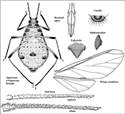Classification
Lachninae: Lachnini
Common name(s)
Giant willow aphid
Diagnosis
Very large aphids of 5 to 5.8 mm length, always colonise on woody plant parts and lower surface of old leaves. Abdominal dorsum pale, membranous, bearing some dark markings on first to sixth tergites, besides a slender sclerotic transverse band on eighth tergite. Fourth tergite with a large, conspicuous dark brown to black conical dorsal tubercle. Siphunculi on large dark hair bearing cones. Legs black with basal portion of femora reddish. Antennae almost half of the body length. Processus terminalis 0.58 times as long as the base of last antennal segment. Wing venation normal.
Host plant(s)
Salicaceae: Salix tetrasperma Roxb.
Measurements
Aptera: Length of body 5.8, width 3.5; antennae 2.8, segments III: IV: V: VI: 1.21: 0.45: 0.55: (0.17+0.10); u.r.s. 0.24; h.t.2 0.33; siphunculus, base 0.55, apex 0.16.
Alata: Length of body 5.36, width 2.8; antennae 2.00, segments III: IV: V: VI: 0.75: 0.30: 0.33 (0.21+0.06); u.r.s. 0.20; h.t.2 0.36; siphunculus, base 0.69, apex 0.14.
Seasonal occurrence
March-May and September-October.
Natural enemies
Hymenoptera: Braconidae: Aphidiinae: Lipolexis scutellaris Mackauer, Pauesia salignae (Watanabe).


